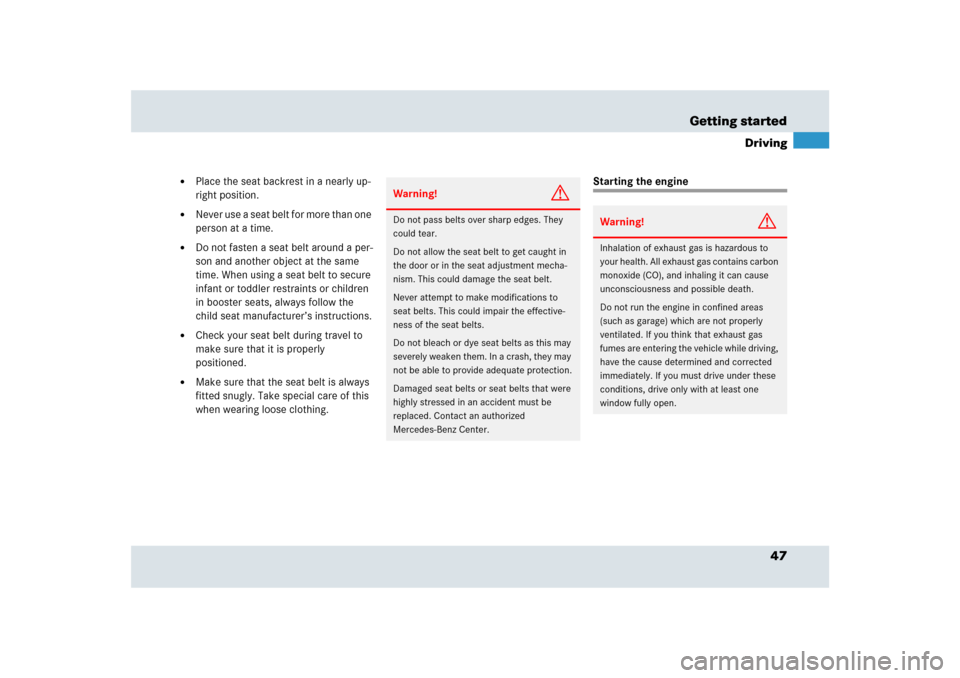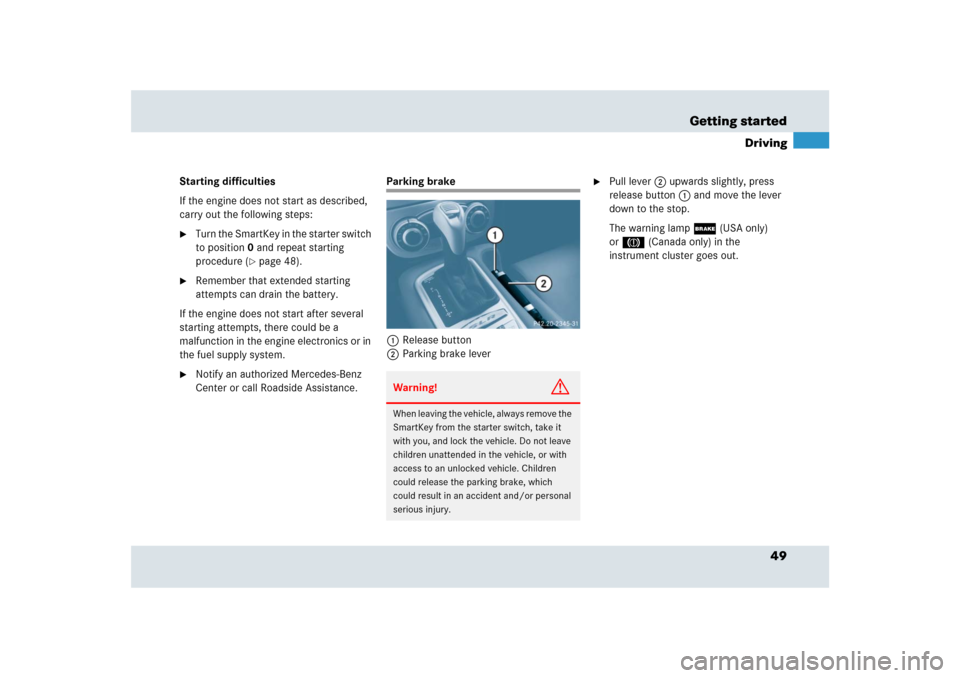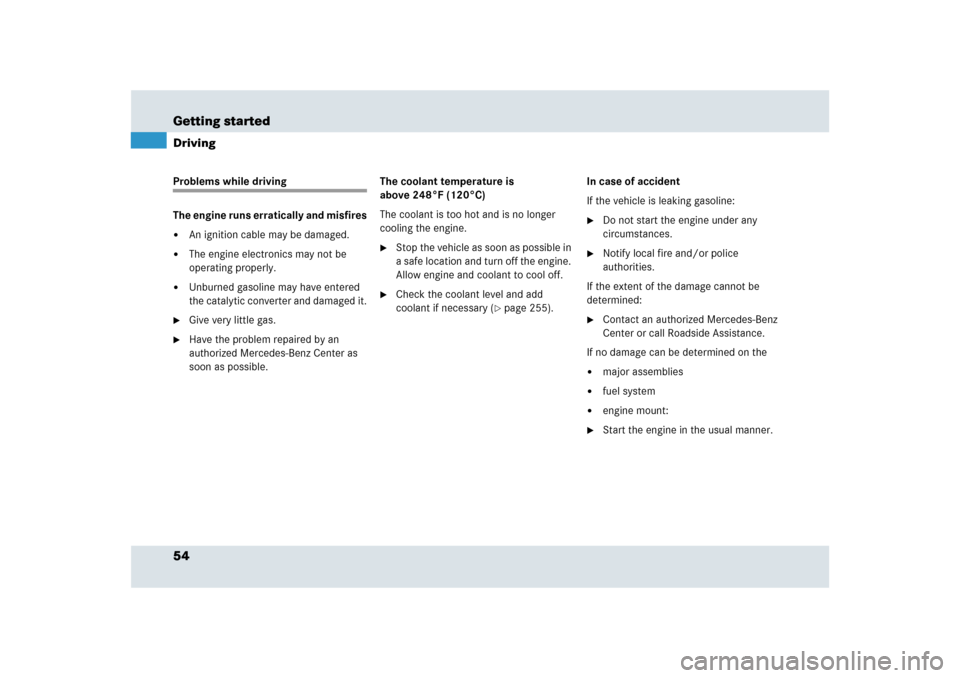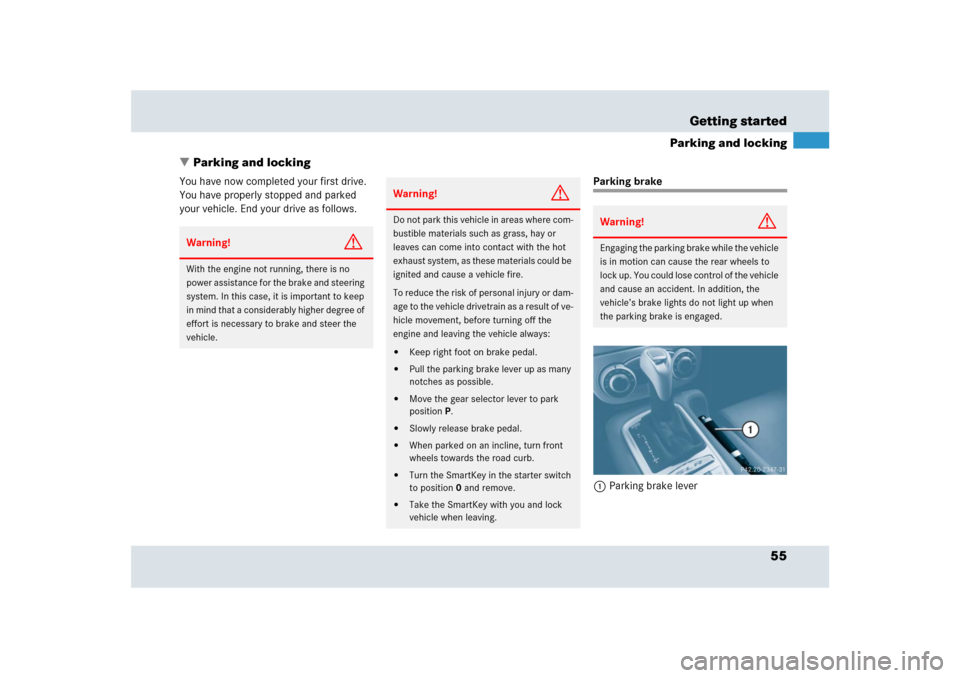Page 31 of 426
31 At a glance
Center console
�Center console
Upper part
Item
Page
1
Central locking switch
105
2
Hazard warning flasher
on/off switch
111
3
Central unlocking switch
105
4
Air temperature controls for
center and side air vents
190
5
Air volume controls for center
and side air vents
191
6
Selects the shift program
mode
175
Item
Page
7
Selects the Airbrake mode
90
8
Selects the manual shift
program mode
179
9
Audio system
120,
145
a
Automatic climate control
184
b
Engine start button
48
Page 40 of 426

40 Getting startedUnlockingStarter switch positions
Starter switch0For removing SmartKey
1Power supply for some consumers
2Ignition (power supply for all consum-
ers) and drive position. All lamps (ex-
cept high-beam headlamp indicator
lamp and turn signal indicator lamps
unless activated) in the instrument
cluster come on. If a lamp in the instru-
ment cluster fails to come on when the
ignition is switched on, have it checked
and replaced if necessary. If a lamp in
the instrument cluster remains on after
starting the engine or comes on while
driving, see “Lamps in instrument clus-
ter” (
�page 304).
Warning!
G
When leaving the vehicle, always remove the
SmartKey from the starter switch, take it
with you, and lock the vehicle. Do not leave
children unattended in the vehicle, or with
access to an unlocked vehicle. A child’s
unsupervised access to a vehicle could
result in an accident and/or serious
personal injury.
i
When you switch on the ignition, the
indicator and warning lamps (except high-beam
headlamp indicator lamp and turn signal indica-
tor lamps unless activated) in the instrument
cluster come on. The indicator and warning
lamps (except high-beam headlamp indicator
lamp and turn signal indicator lamps if activated)
should go out when the engine is running. This
indicates that the respective systems are
operational.
!
If the SmartKey is left in the starter switch
position0 for an extended period of time, it can
no longer be turned in the starter switch.
�
Remove the SmartKey from the starter
switch and reinsert.
If the SmartKey can still not be turned in the
starter switch, the starter battery may not be
sufficiently charged.
�
Have the starter battery checked and
charged if necessary (
�page 371). Contact
an authorized Mercedes-Benz Center.
To prevent accelerated battery discharge and a
possible dead battery, always remove the Smart-
Key from the starter switch when the engine is
not in operation.
Page 47 of 426

47 Getting started
Driving
�
Place the seat backrest in a nearly up-
right position.
�
Never use a seat belt for more than one
person at a time.
�
Do not fasten a seat belt around a per-
son and another object at the same
time. When using a seat belt to secure
infant or toddler restraints or children
in booster seats, always follow the
child seat manufacturer’s instructions.
�
Check your seat belt during travel to
make sure that it is properly
positioned.
�
Make sure that the seat belt is always
fitted snugly. Take special care of this
when wearing loose clothing.
Starting the engine
Warning!
G
Do not pass belts over sharp edges. They
could tear.
Do not allow the seat belt to get caught in
the door or in the seat adjustment mecha-
nism. This could damage the seat belt.
Never attempt to make modifications to
seat belts. This could impair the effective-
ness of the seat belts.
Do not bleach or dye seat belts as this may
severely weaken them. In a crash, they may
not be able to provide adequate protection.
Damaged seat belts or seat belts that were
highly stressed in an accident must be
replaced. Contact an authorized
Mercedes-Benz Center.
Warning!
G
Inhalation of exhaust gas is hazardous to
your health. All exhaust gas contains carbon
monoxide (CO), and inhaling it can cause
unconsciousness and possible death.
Do not run the engine in confined areas
(such as garage) which are not properly
ventilated. If you think that exhaust gas
fumes are entering the vehicle while driving,
have the cause determined and corrected
immediately. If you must drive under these
conditions, drive only with at least one
window fully open.
Page 48 of 426
48 Getting startedDrivingGearshift pattern P Park position with gear selector lever
lock
R Reverse gear
N Neutral position
D Drive position
For more information, see “Automatic
transmission” (
�page 169).1Cover
2Start button
�
Make sure the gear selector lever is set
to park positionP.
�
Do not depress the accelerator.
�
Switch on the ignition (
�page 40).
�
Lift up cover1.
�
Press start button2 once.
The engine starts.
�
Close cover1.For information on turning off the engine,
see “Turning off the engine” (
�page 56).
Warning!
G
Make sure the cover of the start button is
closed after starting the engine. Otherwise
you could be injured on the open cover in an
accident or during driving maneuvers.
Page 49 of 426

49 Getting started
Driving
Starting difficulties
If the engine does not start as described,
carry out the following steps:�
Turn the SmartKey in the starter switch
to position0 and repeat starting
procedure (
�page 48).
�
Remember that extended starting
attempts can drain the battery.
If the engine does not start after several
starting attempts, there could be a
malfunction in the engine electronics or in
the fuel supply system.
�
Notify an authorized Mercedes-Benz
Center or call Roadside Assistance.
Parking brake
1Release button
2Parking brake lever
�
Pull lever2 upwards slightly, press
release button1 and move the lever
down to the stop.
The warning lamp; (USA only)
or3 (Canada only) in the
instrument cluster goes out.
Warning!
G
When leaving the vehicle, always remove the
SmartKey from the starter switch, take it
with you, and lock the vehicle. Do not leave
children unattended in the vehicle, or with
access to an unlocked vehicle. Children
could release the parking brake, which
could result in an accident and/or personal
serious injury.
Page 50 of 426

50 Getting startedDrivingDriving off�
Depress the brake pedal.
The gear selector lever lock is released.
�
Place the gear selector lever in drive
positionD or reverse gearR.
�
Release the brake pedal.
�
Carefully depress the accelerator
pedal.After a cold start, the transmission engag-
es at a higher revolution. This allows the
catalytic converter to reach its operating
temperature earlier.
Warning!
G
It is dangerous to shift the gear selector le-
ver out of park positionP or neutral
positionN if the engine speed is higher than
idle speed. If your foot is not firmly on the
brake pedal, the vehicle could accelerate
quickly forward or in reverse. You could lose
control of the vehicle and hit someone or
something. Only shift into gear when the en-
gine is idling normally and when your right
foot is firmly on the brake pedal.
Warning!
G
On slippery road surfaces, never downshift
in order to obtain braking action. This could
result in drive wheel slip and reduced vehi-
cle control. Your vehicle’s ABS will not pre-
vent this type of loss of control.!
In order to avoid damage to the
transmission:
�
Wait for the gear selection process to com-
plete before setting the vehicle in motion.
�
Place the gear selector lever in reverse
gearR or park positionP only when the vehi-
cle is stopped.
!
If you hear a warning signal and the mes-
sage Release Parking Brake
appears in the multifunction display when driving
off, you have forgotten to release the parking
brake.
Release the parking brake (
�page 49).
!
Do not run cold engine at high engine speed.
Running a cold engine at high engine speed may
shorten the service life of the engine.
!
Simultaneously depressing the accelerator
pedal and applying the brakes reduces engine
performance and causes premature brake and
drivetrain wear.
i
Once the vehicle is in motion, the automatic
central locking system engages.
You can deactivate the automatic locking using
the control system (
�page 139).
You can open a locked door from the inside.
Open door only when conditions are safe to do
so.
Page 54 of 426

54 Getting startedDrivingProblems while driving
The engine runs erratically and misfires�
An ignition cable may be damaged.
�
The engine electronics may not be
operating properly.
�
Unburned gasoline may have entered
the catalytic converter and damaged it.
�
Give very little gas.
�
Have the problem repaired by an
authorized Mercedes-Benz Center as
soon as possible.The coolant temperature is
above 248°F (120°C)
The coolant is too hot and is no longer
cooling the engine.
�
Stop the vehicle as soon as possible in
a safe location and turn off the engine.
Allow engine and coolant to cool off.
�
Check the coolant level and add
coolant if necessary (
�page 255).In case of accident
If the vehicle is leaking gasoline:
�
Do not start the engine under any
circumstances.
�
Notify local fire and/or police
authorities.
If the extent of the damage cannot be
determined:
�
Contact an authorized Mercedes-Benz
Center or call Roadside Assistance.
If no damage can be determined on the
�
major assemblies
�
fuel system
�
engine mount:
�
Start the engine in the usual manner.
Page 55 of 426

55 Getting started
Parking and locking
�Parking and locking
You have now completed your first drive.
You have properly stopped and parked
your vehicle. End your drive as follows.
Parking brake
1Parking brake lever
Warning!
G
With the engine not running, there is no
power assistance for the brake and steering
system. In this case, it is important to keep
in mind that a considerably higher degree of
effort is necessary to brake and steer the
vehicle.
Warning!
G
Do not park this vehicle in areas where com-
bustible materials such as grass, hay or
leaves can come into contact with the hot
exhaust system, as these materials could be
ignited and cause a vehicle fire.
To reduce the risk of personal injury or dam-
age to the vehicle drivetrain as a result of ve-
hicle movement, before turning off the
engine and leaving the vehicle always:�
Keep right foot on brake pedal.
�
Pull the parking brake lever up as many
notches as possible.
�
Move the gear selector lever to park
positionP.
�
Slowly release brake pedal.
�
When parked on an incline, turn front
wheels towards the road curb.
�
Turn the SmartKey in the starter switch
to position0 and remove.
�
Take the SmartKey with you and lock
vehicle when leaving.
Warning!
G
Engaging the parking brake while the vehicle
is in motion can cause the rear wheels to
lock up. You could lose control of the vehicle
and cause an accident. In addition, the
vehicle’s brake lights do not light up when
the parking brake is engaged.